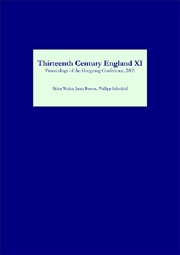Book contents
- Frontmatter
- Contents
- LIST OF ILLUSTRATIONS
- PREFACE
- CONTRIBUTORS
- ABBREVIATIONS
- ‘Adam of Bristol’ and Tales of Ritual Crucifixion in Medieval England
- Ethics and Office in England in the Thirteenth Century
- Some Aspects of the Royal Itinerary in the Twelfth Century
- The minority governments of Henry III, Henry (VII) and Louis IX compared
- Scottish Queenship in the Thirteenth Century
- Ethnicity, personal names, and the nature of Scottish Europeanization
- Power, Preaching and the Crusades in Pura Wallia c.1180–c.1280
- A Forgotten War: England and Navarre, 1243·4
- The Appointment of Cardinal-deacon Otto as Legate in Britain (1237)
- Matthew Paris and John Mansel
- The Burial of Noblewomen in Thirteenth-Century Shropshire
- Dynastic Conflict in thirteenth-century Laxton
- Absenteeism: The Chronology of a Concept
The Appointment of Cardinal-deacon Otto as Legate in Britain (1237)
Published online by Cambridge University Press: 12 September 2012
- Frontmatter
- Contents
- LIST OF ILLUSTRATIONS
- PREFACE
- CONTRIBUTORS
- ABBREVIATIONS
- ‘Adam of Bristol’ and Tales of Ritual Crucifixion in Medieval England
- Ethics and Office in England in the Thirteenth Century
- Some Aspects of the Royal Itinerary in the Twelfth Century
- The minority governments of Henry III, Henry (VII) and Louis IX compared
- Scottish Queenship in the Thirteenth Century
- Ethnicity, personal names, and the nature of Scottish Europeanization
- Power, Preaching and the Crusades in Pura Wallia c.1180–c.1280
- A Forgotten War: England and Navarre, 1243·4
- The Appointment of Cardinal-deacon Otto as Legate in Britain (1237)
- Matthew Paris and John Mansel
- The Burial of Noblewomen in Thirteenth-Century Shropshire
- Dynastic Conflict in thirteenth-century Laxton
- Absenteeism: The Chronology of a Concept
Summary
On 12 February 1237 Pope Gregory IX appointed Otto da Tonengo, Cardinal-deacon of St Nicholas in carcere Tuillano, as his legate de latere in England, Wales and Ireland. Scotland too fell within the ambit of Otto's authority for on 24 March he was instructed to bring about a peace settlement between the kings of Scotland and England, and in early May, after Otto had left the curia, the pope extended his legatine authority to the northern kingdom as well. Hence, upon his arrival at Dover in mid-July he wielded influence over the larger part of the British Isles; indeed the only areas outside his jurisdiction were the Isle of Man and the Western Isles of Scotland, which belonged to the ecclesiastical province of Nidaros and were nominally at least in the possession of the king of Norway. He remained for nearly three and a half years (departing on 5 January 1241) during which time he quite simply dominated the realm and was described by one contemporary, albeit in unflattering but equally correct terms, as ‘Otto the legate, in effect another pope …’
Many historians have long recognised the important role that Otto played as legate in Britain. He has been remembered for such things as the canons of London, which were promulgated at the legatine council held at St Paul's in November 1237, and the later reformatory statutes he laid out for the Benedictine Order.
- Type
- Chapter
- Information
- Thirteenth Century England XIProceedings of the Gregynog Conference, 2005, pp. 147 - 158Publisher: Boydell & BrewerPrint publication year: 2007



